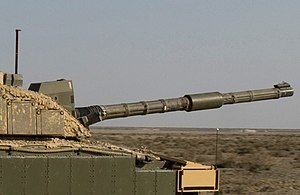L30
| L30 | |
|---|---|

Gun of a Challenger 2 tank of the Royal Scots Dragoon Guards, Basra, Iraq, November 2008
|
|
| Place of origin | United Kingdom |
| Service history | |
| In service | 1989–Present |
| Used by | UK, Oman |
| Production history | |
| Designer | Royal Ordnance Factory, Nottingham |
| Manufacturer | Royal Ordnance Factories |
| Specifications | |
| Barrel length | 55 calibres (6.6 meters) |
|
|
|
| Calibre | 120 mm (4.7 in) |
The L30 is a 120 mm rifled tank gun used by the British Army and Royal Army of Oman. It is fitted in the turret of the Challenger 2 main battle tank. It is an improved production model of the Royal Ordnance L11 series of rifled tank guns.
The Challenger Armament or CHARM project was intended to provide a new main armament for the Challenger II tank and to be retro-fitted to the Challenger 1. It involved three components: the gun, developed by the Royal Ordnance Factory, Nottingham, the Depleted Uranium (DU) APFSDS round, and a propellant charge for it.
After earlier projects were cancelled, the EXP 32M1 experimental gun was re-titled the XL30E3 and accepted for production as the L30 in 1989.
The barrel is 55 calibres long (L55) and is made of electro-slag refined (ESR) steel. The bore and chamber are electro-plated with chromium to give a barrel life of 1,500 effective full charges.
The breech mechanism is a split sliding-block breech. One vertically sliding block holds the obturation ring (which is necessary because the propellant charges are combustible cases or bags) and is locked for firing by a second block. When the second block falls, the first is released to open the breech.
The ammunition types which are currently or were formerly in use include:
...
Wikipedia
